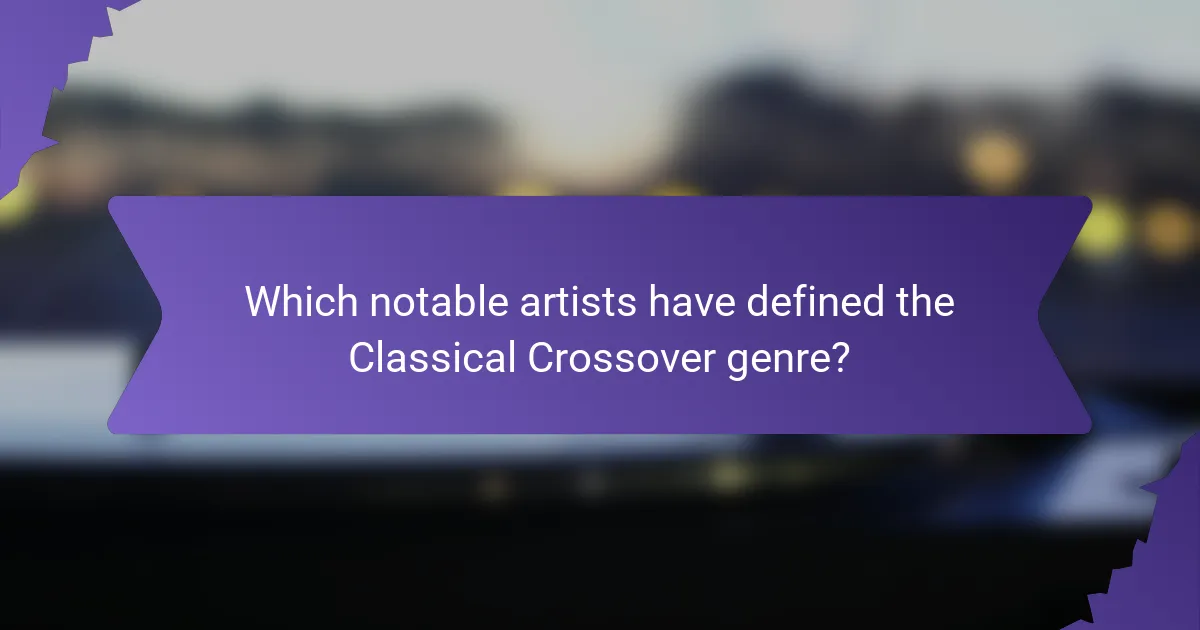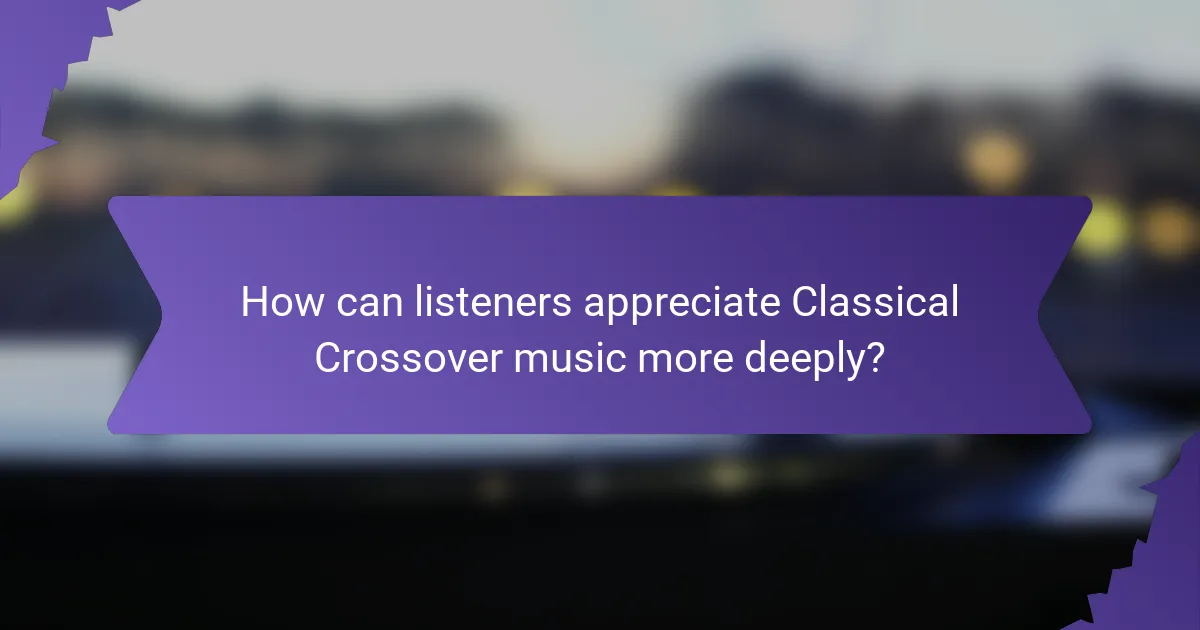Classical crossover music captivates audiences by merging classical elements with popular genres like pop and rock. This article explores the genre’s innovative fusion, its rising popularity, and notable artists like Andrea Bocelli and Il Divo. It also addresses the challenges faced by artists within this space and offers insights on deepening listener appreciation through live performances and historical context.

How does Classical Crossover blend different musical genres?
Classical crossover blends different musical genres by combining elements of classical music with popular styles such as pop, rock, and jazz. This fusion creates a unique sound that appeals to diverse audiences. Notable artists like Andrea Bocelli and Il Divo exemplify this genre by merging operatic vocals with contemporary arrangements. The genre’s popularity stems from its ability to attract classical music enthusiasts and mainstream listeners alike, showcasing the versatility and emotional depth of both musical worlds.
What are the key characteristics of Classical Crossover?
Classical crossover blends elements of classical music with popular genres, creating a unique sound. Key characteristics include orchestral arrangements, vocal performances, and accessibility. Notable artists like Andrea Bocelli and Il Divo exemplify this genre’s appeal, merging technical skill with mainstream popularity. This fusion attracts diverse audiences, expanding classical music’s reach beyond traditional boundaries.
Which genres are commonly fused in Classical Crossover?
Classical crossover commonly fuses genres such as classical, pop, rock, and jazz. This blending creates a unique sound appealing to diverse audiences. Notable examples include artists like Andrea Bocelli and Il Divo, who integrate operatic elements with contemporary music styles. These genre fusions enhance the accessibility and popularity of classical music in modern culture.

What drives the popularity of Classical Crossover music?
Classical Crossover music’s popularity stems from its innovative blend of classical and contemporary genres, appealing to diverse audiences. This genre attracts listeners by combining familiar melodies with modern production techniques. Notable artists, such as Andrea Bocelli and Il Divo, have successfully brought classical elements into mainstream music, enhancing its reach. Additionally, the emotional depth and accessibility of classical crossover performances resonate with fans, making it a beloved genre worldwide.
How do cultural influences shape the appeal of Classical Crossover?
Cultural influences significantly enhance the appeal of Classical Crossover by blending diverse musical traditions. This genre’s fusion attracts varied audiences, reflecting global tastes and preferences. Notable artists like Andrea Bocelli and Il Divo exemplify this trend, incorporating elements from pop and classical music. The genre’s ability to resonate across cultures creates a unique listening experience, fostering broader appreciation and popularity.
What role do digital platforms play in the growth of Classical Crossover?
Digital platforms significantly enhance the growth of Classical Crossover by expanding audience reach and enabling artist promotion. Streaming services like Spotify and Apple Music allow listeners to discover this genre easily. Social media platforms facilitate direct engagement between artists and fans, fostering community and loyalty. Additionally, digital marketing strategies help artists showcase their unique styles, attracting diverse demographics. The accessibility of online content has led to a surge in popularity for Classical Crossover, making it a dynamic part of the contemporary music landscape.

Which notable artists have defined the Classical Crossover genre?
Notable artists who have defined the Classical Crossover genre include Andrea Bocelli, Il Divo, and Sarah Brightman. These artists blend classical music elements with popular styles, achieving widespread acclaim and commercial success. Andrea Bocelli, known for his powerful tenor voice, has sold over 90 million records worldwide. Il Divo, a vocal group formed in 2003, combines operatic singing with pop music, appealing to diverse audiences. Sarah Brightman, a soprano and actress, has played a significant role in popularizing the genre through her theatrical performances and collaborations. These artists exemplify the fusion of classical and contemporary music, contributing to the genre’s growth and popularity.
What unique contributions have artists like Andrea Bocelli made?
Artists like Andrea Bocelli have significantly enriched the classical crossover genre by blending classical music with pop elements. His unique vocal style and emotional delivery have expanded the audience for classical music, attracting listeners who may not typically engage with the genre. Bocelli’s collaborations with contemporary artists have further bridged the gap between classical and popular music, showcasing the versatility of classical compositions. His global tours and record sales illustrate the widespread appeal of this fusion, making classical crossover a prominent and influential genre in the music industry.
How have female artists influenced the Classical Crossover scene?
Female artists have significantly shaped the Classical Crossover scene by blending classical elements with popular music styles. Their innovative approaches have expanded the genre’s appeal and accessibility. Artists like Andrea Bocelli and Sarah Brightman have achieved remarkable success, with Brightman selling over 30 million albums worldwide. The unique attribute of female vocalists often includes a diverse range of training, from opera to pop, enabling a richer fusion of sounds. This influence has led to increased popularity and a broader audience for Classical Crossover, showcasing its versatility and emotional depth.

What are the challenges faced by Classical Crossover artists?
Classical Crossover artists face challenges such as genre classification, audience expectations, and market saturation. These factors can hinder their ability to gain recognition and maintain a unique identity.
Genre classification often leads to ambiguity, making it difficult for artists to find their niche. Audience expectations can create pressure to conform to popular trends, limiting creative expression. Market saturation complicates visibility, as numerous artists vie for attention in a crowded space.
Additionally, securing performance opportunities can be challenging due to the specialized nature of the genre. Funding for projects may also be limited, impacting production quality and reach.
Overall, these challenges require Classical Crossover artists to navigate a complex landscape while striving to innovate and connect with their audience.
How do Classical Crossover artists navigate genre expectations?
Classical crossover artists navigate genre expectations by blending classical music with popular styles. They often experiment with instrumentation, vocal techniques, and song selection to appeal to diverse audiences. This fusion allows them to reach mainstream success while maintaining classical roots. Notable artists like Andrea Bocelli and Il Divo exemplify this balance, drawing fans from both genres. Their ability to reinterpret classical pieces in contemporary contexts enhances their popularity and broadens the genre’s appeal.
What common misconceptions exist about Classical Crossover?
Many misconceptions about Classical Crossover include the belief that it lacks authenticity and is merely a commercial trend. Critics often argue that blending classical music with pop elements dilutes its richness. However, notable artists like Andrea Bocelli and Il Divo demonstrate that this genre can maintain artistic integrity while reaching wider audiences. Additionally, some think Classical Crossover is a new phenomenon, but its roots trace back to earlier collaborations, showcasing a long-standing tradition of genre fusion.

How can listeners appreciate Classical Crossover music more deeply?
Listeners can appreciate Classical Crossover music more deeply by exploring its diverse influences and emotional depth. Engaging with the genre’s blend of classical and contemporary elements enhances understanding. Notable artists like Andrea Bocelli and Il Divo showcase unique styles, making the genre accessible. Attending live performances allows for a richer experience, as the emotional connection in a concert setting amplifies appreciation. Additionally, understanding the historical context of the pieces performed can deepen the listener’s connection to the music.
What are the best practices for exploring Classical Crossover albums?
To explore Classical Crossover albums effectively, focus on key artists, popular tracks, and diverse influences. Listen to a mix of traditional and contemporary pieces to appreciate the genre’s fusion. Research notable collaborations that showcase unique attributes, such as vocal techniques or orchestral arrangements. Attend live performances to experience the genre’s energy and connect with the community.
Which performances or recordings are essential for newcomers?
Essential recordings for newcomers to classical crossover include “The Prayer” by Andrea Bocelli and Céline Dion, “Time to Say Goodbye” by Andrea Bocelli and Sarah Brightman, and “Vivo per lei” by Bocelli. These performances showcase the genre’s blend of classical and popular music. Notable artists like Il Divo and Josh Groban further exemplify this fusion, making their albums essential listening for enthusiasts.
What common mistakes should listeners avoid when engaging with Classical Crossover?
Listeners should avoid common mistakes like underestimating the genre’s complexity and misinterpreting the fusion of styles. Many assume Classical Crossover is merely pop with orchestral backing, neglecting its rich musical heritage. Ignoring the nuances of both classical and contemporary elements can lead to a superficial appreciation. Additionally, failing to explore various artists and their unique interpretations limits understanding of the genre’s diversity. Engaging with Classical Crossover requires an open mind and a willingness to appreciate its intricate blend of influences.